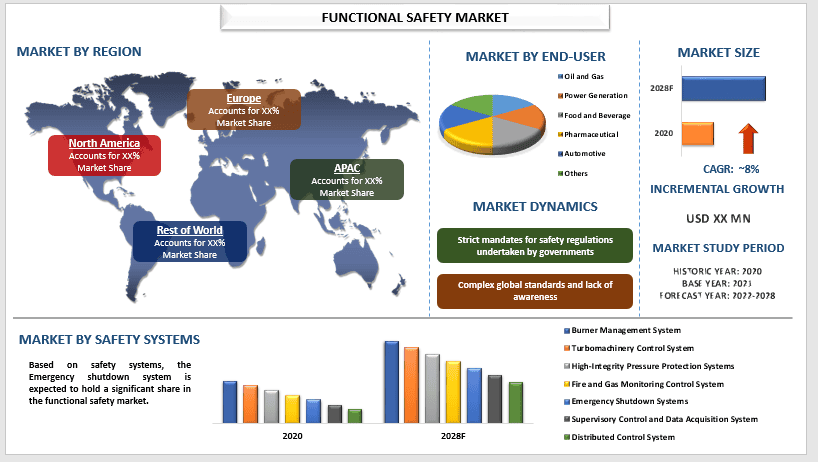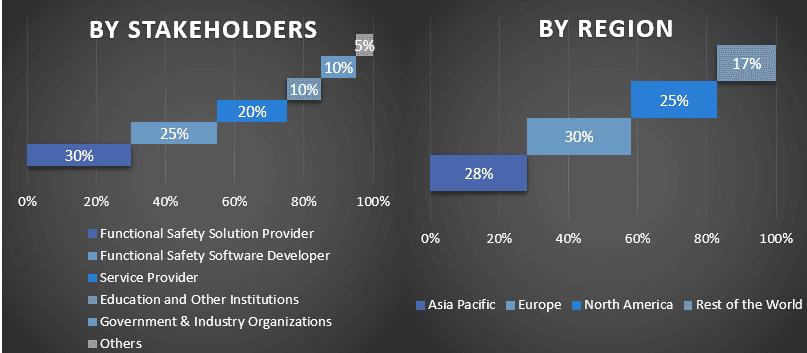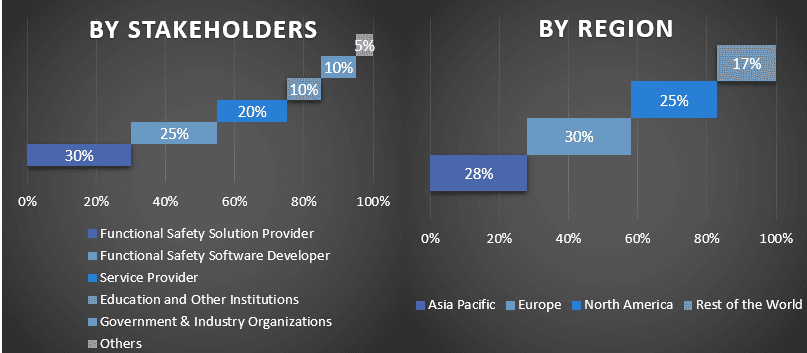Emphasis on Device Type (Safety Sensors, Safety controllers/Modules/Relays, Safety Switches, Programmable Safety Systems, Emergency Stop Devices, Final Control Elements, and Others); Safety Systems (Burner Management System, Turbomachinery Control System, High-Integrity Pressure Protection Systems, Fire & Gas Monitoring Control System, Emergency Shutdown Systems, Supervisory Control & Data Acquisition System, Distributed Control System); and Region/Country

The global Functional Safety Market is expected to grow at a significant rate of around 8% during the forecast period. Functional safety is an important part of an entire safety approach that relies on a system or component of equipment functioning appropriately to its inputs. Industry 4.0 provides a new all-encompassing concept for modern factories. The significance of safety in such modern factories cannot be overstated. Functional safety enables users to get assurance that a part of equipment can perform its function safely while relying upon its use. Also, the rapid demand for safety systems in the oil and gas industry and the rise in the requirement for reliable safety systems to ensure personnel and asset protection are also anticipated to flourish the growth of the functional safety market.
Furthermore, the increasing number of power projects to meet the increased demand for energy has accelerated the deployment of functional safety systems at plant locations, such as burner management and fire and gas systems. With the growing industrialization, the usage of safety automation solutions in manufacturing industries in this area is expanding considerably, adding to the market development.
Omron Corporation, Schneider Electric SE, Siemens AG, ABB Ltd, Rockwell Automation, Inc., Yokogawa Electric Corporation, TUVRheiland AG, Emerson Electric Co., Bosch Rexroth AG, and General Electric are some of the key players in the market. Several M&As along with partnerships have been undertaken by these players to facilitate customers with hi-tech and innovative products/technologies.
Insights Presented in the Report
“Amongst device type, safety sensors category to witness robust CAGR during the forecast period”
Based on device type, the functional safety market is segmented into safety sensors, safety controllers/modules/relays, safety switches, programmable safety systems, and others. Safety sensors category to witness higher CAGR during the forecast period. Sensors deployed in a safety system are developed and designed to ensure a safe output based on the logic in case of a measurement or signal transmission does not occur. These safety sensors include the elements of redundancy wherein if any one element fails, then another takes control over the operation, and thus avoids productivity losses resulting from shutdown.
“Amongst safety systems, emergency service systems segment to hold a significant share in the market in 2020”
Based on safety systems, the functional safety market is classified into the burner management system, turbomachinery control system, high-integrity pressure protection systems, fire and gas monitoring control system, emergency shutdown systems, supervisory control, and data acquisition system, and distributed control system. Among these, the emergence service systems segment to hold a significant share in the market in 2020. As it brings the production facilities to a safe state and protects the personnel, the assets, and the environment if hazardous situations occur.
“Amongst end-user, automotive segment to hold a significant share in the market in 2020”
Based on End-User, the functional safety market has been classified into oil and gas, power generation, food, and beverage, pharmaceutical, automotive, and others. The automotive segment is to witness higher adoption of the functional safety market during the forecast period. These sensors are developed and designed to ensure a safe output based on the logic in case of a measurement or signal transmission does not occur. Also, Safety sensor-based products are incorporated into functional safety systems for different applications such as to sense movement and position of machinery, tracking tooling data, and helping integrate automated systems.
“APAC to hold a significant share in the market”
APAC is anticipated to grow at a substantial CAGR during the forecast period. This is mainly due to the increase in industrialization in developing nations such as China and India. Furthermore, the increased acceptance of international functional safety standards in the region is mainly due to the robust growth of heavily regulated industries such as oil & gas and power.
Reasons to buy this report:
Customization Options:
The global Functional Safety market can further be customized as per the requirement or any other market segment. Besides this, UMI understands that you may have your own business needs, hence feel free to connect with us to get a report that completely suits your requirements.
1. Market Introduction
2. Research Methodology Or Assumption
3. Market Synopsis
4. Executive Summary
5. Impact Of Covid-19 On The Functional Safety Market
6. Functional Safety Market Revenue (usd Bn), 2020-2028f
7. Market Insights By Device Type
8. Market Insights By Safety Systems
9. Market Insights By End-user
10. Market Insights By Region
11. Functional Safety Market Dynamics
12. Functional Safety Market Opportunities
13. Functional Safety Market Trends
14. Demand And Supply-side Analysis
15. Value Chain Analysis
16. Competitive Scenario
17. Company Profiled
18. Disclaimer
Research Methodology for the Functional Safety Market Analysis (2022-2028)
Analyzing the historical market, estimating the current market, and forecasting the future market of the global Functional Safety market were the three major steps undertaken to create and analyze the adoption of functional safety in major regions globally. Exhaustive secondary research was conducted to collect the historical market numbers and estimate the current market size. Secondly, to validate these insights, numerous findings and assumptions were taken into consideration. Moreover, exhaustive primary interviews were also conducted, with industry experts across the value chain of the global functional safety market. Post assumption and validation of market numbers through primary interviews, we employed a top-down/bottom-up approach to forecasting the complete market size. Thereafter, market breakdown and data triangulation methods were adopted to estimate and analyze the market size of segments and sub-segments of the industry pertains to. Detailed methodology is explained below:
Analysis of Historical Market Size
Step 1: In-Depth Study of Secondary Sources:
Detail secondary study was conducted to obtain the historical market size of the functional safety market through company internal sources such as annual reports & financial statements, performance presentations, press releases, etc., and external sources including journals, news & articles, government publications, competitor publications, sector reports, third-party database, and other credible publications.
Step 2: Market Segmentation:
After obtaining the historical market size of the functional safety market, we conducted a detailed secondary analysis to gather historical market insights and share for different segments & sub-segments for major regions. Major segments are included in the report as device type, safety systems, and end-user. Further country-level analyses were conducted to evaluate the overall adoption of testing models in that region.
Step 3: Factor Analysis:
After acquiring the historical market size of different segments and sub-segments, we conducted a detailed factor analysis to estimate the current market size of the functional safety market. Further, we conducted factor analysis using dependent and independent variables such as various device type, safety systems, and end-user. A thorough analysis was conducted for demand and supply-side scenarios considering top partnerships, mergers and acquisitions, business expansion, and product launches in the Functional Safety market sector across the globe.
Current Market Size Estimate & Forecast
Current Market Sizing: Based on actionable insights from the above 3 steps, we arrived at the current market size, key players in the global functional safety market, and market shares of the segments. All the required percentage shares split, and market breakdowns were determined using the above-mentioned secondary approach and were verified through primary interviews.
Estimation & Forecasting: For market estimation and forecast, weights were assigned to different factors including drivers & trends, restraints, and opportunities available for the stakeholders. After analyzing these factors, relevant forecasting techniques i.e., the top-down/bottom-up approach were applied to arrive at the market forecast for 2028 for different segments and sub-segments across the major markets globally. The research methodology adopted to estimate the market size encompasses:
Market Size and Share Validation
Primary Research: In-depth interviews were conducted with the Key Opinion Leaders (KOLs) including Top Level Executives (CXO/VPs, Sales Head, Marketing Head, Operational Head, Regional Head, Country Head, etc.) across major regions. Primary research findings were then summarized, and statistical analysis was performed to prove the stated hypothesis. Inputs from primary research were consolidated with secondary findings, hence turning information into actionable insights.
Split of Primary Participants in Different Regions

Market Engineering
The data triangulation technique was employed to complete the overall market estimation and to arrive at precise statistical numbers for each segment and sub-segment of the global functional safety market. Data was split into several segments & sub-segments post studying various parameters and trends in the areas of device type, safety systems, and end-user in the global functional safety market.
The main objective of the Global Functional Safety Market Study
The current & future market trends of the global functional safety market were pinpointed in the study. Investors can gain strategic insights to base their discretion for investments on the qualitative and quantitative analysis performed in the study. Current and future market trends determined the overall attractiveness of the market at a regional level, providing a platform for the industrial participant to exploit the untapped market to benefit from a first-mover advantage. Other quantitative goals of the studies include:

Customers who bought this item also bought